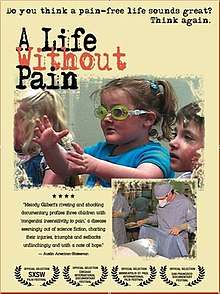A Life Without Pain
A Life Without Pain is a 2005 documentary film by Melody Gilbert about children who can't feel pain.[1]
| A Life Without Pain | |
|---|---|
 | |
| Directed by | Melody Gilbert |
| Produced by | Melody Gilbert |
| Cinematography | Melody Gilbert |
| Edited by | Charlie Gerszewski |
Release date |
|
| Country | United States |
| Language | English |
Plot synopsis
The film explores the daily lives of three children with Congenital insensitivity to pain, a rare genetic disorder shared by just a hundred people in the world.[2] Three-year-old Gabby from Minnesota, 7-year-old Miriam from Norway and 10-year-old Jamilah from Germany have to be carefully guarded by their parents so they don't suffer serious, life-altering injuries.
Reception
The release of the film garnered widespread interest in the topic, and the character Gabby was featured on The Oprah Winfrey Show in 2006.[3]
gollark: Oh right.
gollark: Oh, seriously?
gollark: ++tel link discord 828679758136213541 yes
gollark: ++magic reload_ext telephone
gollark: ++tel link discord 828679758136213541 yes
References
- A Life Without Pain at IMDB
- http://www.alifewithoutpain.com/about.php Archived 2009-05-04 at the Wayback Machine retrieved 5/25/09
- http://www.oprah.com/slideshow/oprahshow/oprahshow2_ss_20051108/8
This article is issued from Wikipedia. The text is licensed under Creative Commons - Attribution - Sharealike. Additional terms may apply for the media files.